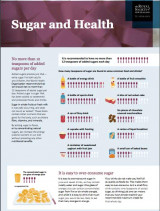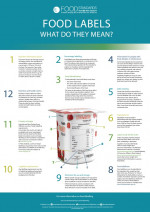Sugar – how to cut it down
Key points about cutting down on sugar
- Sugar is added to a wide range of foods and drinks and is found naturally in some foods.
- Many New Zealanders eat too much added sugar found in highly processed foods and sugary drinks.
- Too much sugar is linked with tooth decay, weight gain and an increased risk of health conditions, eg, type 2 diabetes and heart disease.
- The World Health Organisation and Ministry of Health guidelines recommend eating less sugar for better health.
- The best way to eat less sugar is to eat mostly whole foods, including vegetables, fruit, dairy products, nuts and seeds, and to limit foods and drinks high in sugar.
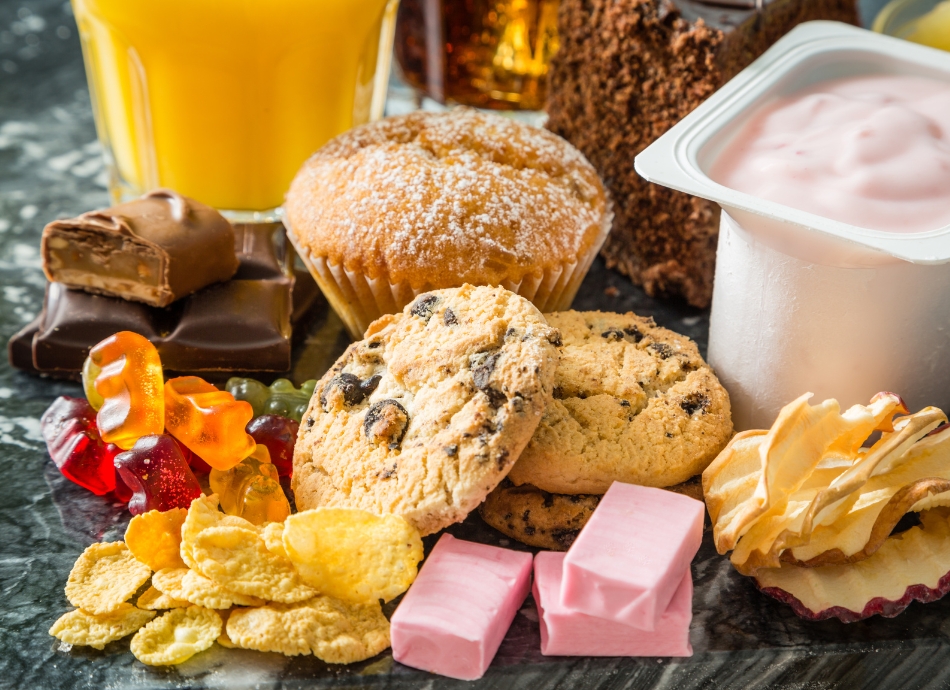
There are a few different types of sugar:
- Natural sugars: Found in whole fruit and dairy products.
- Added sugars: Added to foods and drinks, eg, biscuits, muesli bars, flavoured yoghurts, breakfast cereals, sauces and fizzy drinks. Added sugar increases the energy content (or kilojoules) of a food product and adds no other useful nutrients.
- Free sugars: Added sugars plus the sugar found in honey, syrups and fruit juices. Honey, maple syrup and coconut sugar all sound like ‘healthier’ versions of sugar, but they have the same effect in your body.
When we talk about cutting down on sugar it’s the added and free sugars we should be focusing on. Foods that contain natural sugars provide our bodies with valuable nutrition.
The video below describes the different types of sugars in a simple way.
Video: What are free sugars?
Eating too many foods and drinks high in sugar puts you at higher risk of:
- tooth decay and dental caries
- weight gain (especially around your tummy/puku area)
- type 2 diabetes
- heart disease.
There is clear and consistent evidence that adults and children who consume sugary drinks are more likely to have a higher body weight and body mass index (BMI).
Video: Sugar and health
(Royal Society Te Apārangi, NZ, 2016)
A diet low in sugar is a key part of a healthy eating pattern. Highly processed foods not only contain sugar but are usually sources of saturated fat and salt too.
The World Health Organisation recommends adults limit free sugars to less than 12 teaspoons of sugar a day. That’s about 50 g (1 teaspoon = 4 g of sugar). A further reduction to less than 6 teaspoons of sugar a day is recommended for extra health benefits.
Children should have no more than about 3 to 4 teaspoons of free sugars a day.
Adults
It’s estimated that over half (58%) of New Zealand adults (15+ years of age) are having over 12 teaspoons of free and added sugars each day. Males have higher intakes than females. Younger age groups (especially 15 to 30 years) have much higher intakes too.
Children
The 2002 National Children’s Nutrition Survey found the average daily intake of sugar for boys was 67g (17 teaspoons) and for girls was 61g (15 teaspoons). Sugary drinks contribute a lot to this intake, with 1 study showing 62% of New Zealand children 8 to 12 years of age drinking more than 5 servings of sugary drinks each week.
The image below shows how much sugar is in children's drinks.
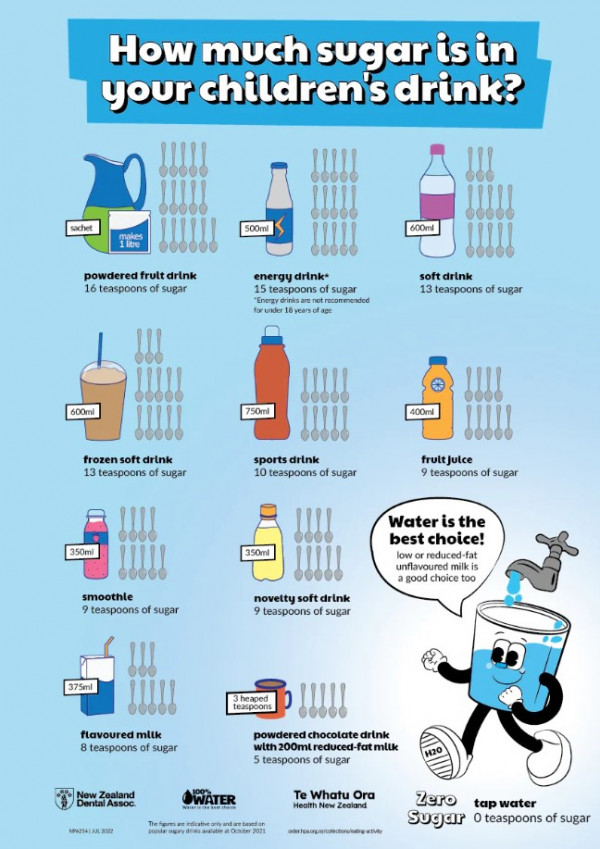
Image credit: Health New Zealand | Te Whatu Ora and New Zealand Dental Association
The best foods for your body are whole foods (eg, vegetables and fruit) and these foods often don't have a food label.
Sugar is hidden in many processed and packaged foods. A food doesn't have to taste sweet to contain sugar.
Nutrition labels show the average amount of energy, protein, fat, saturated fat, carbohydrate, sugars and sodium in a serve and in 100 g (or 100 ml) of the food. It's best to use the per 100 g information so you can compare across similar products. Read more about how to read food labels.
Sugar per 100 g
The total sugar on a nutrition panel includes both natural and added sugars.
- If a food product has less than 5 g of sugar per 100g (or less than 2.5 g per 100 ml) it's considered to be 'low in sugar'.
- If a food product has more than 15 g of sugar per 100 g it may be considered 'high in sugar'.
- It's best to compare similar products to choose the lowest sugar per 100 g.
Ingredients list
Sugar can be called many different names. If you see these names appear in an ingredients list, then sugar has been added to the product:
- Agave nectar
- Dextrose
- Fructose
- Fruit juice
- Glucose
- Honey
- Malt
- Molasses
- Sucrose
- Sugar (brown, raw, caster, invert)
- Treacle.
Claims
Some products have claims, eg, '100% natural', 'no added sugar', or 'refined sugar free' on the front of the packaging. These claims don't mean a product is low in sugar and will often make a product sound healthier than it is.
Sugary drinks are high in sugar and calories and don't have any nutrition benefit. These drinks are less likely to make us full, making it easy to take in more energy (kilojoules) than you need. A 600 ml bottle of fizzy drink contains about 16 teaspoons of sugar.
Video: Sugary drinks – know the facts
Drinks that are usually very high in sugar include:
- Soft drinks/fizzy drinks
- Sports drinks
- Energy drinks
- Fruit drinks
- Powdered drinks
- Cordials
- Flavoured milks
- Iced teas/coffees
Simple ways to cut back on sugary drinks
- Encourage children to drink plain water or milk.
- Pack a reusable water bottle for children to take to school and sports.
- Eat fruit instead of drinking fruit juice. It's lower in sugar and contains vitamins and fibre.
- Gradually add less sugar to hot drinks (eg, tea and coffee).
- Try herbal teas, sparkling water, and water with fruit or fresh herbs as alternatives to sugary drinks.
- Consider the sugar content of pre-mixed alcoholic drinks and mixers (eg, fizzy drinks, juice).
- Get your community involved by asking your school or sports club to encourage and promote water first and to remove sugary drinks from the environment (eg, vending machines).
What about diet or zero drinks?
Diet drinks use sweeteners instead of sugar and usually contain little or no energy (kilojoules). Plain water is always the best choice of drink. However, if you are unable to switch to water, diet drinks in moderation can be a good step away from fizzy drinks.
Here are some simple tips to help you gradually eat fewer sugary foods across the day. If you currently eat a lot of sugary food, it may take some time for your taste buds to adjust.
Breakfast
- Eggs on toast, omelette, chia seed pudding, overnight oats, porridge, avocado on toast are based around foods that are naturally low in sugar.
- Many breakfast cereals are high in sugar. Compare the nutrition labels and choose an option with the lowest sugar per 100 g.
- Add fresh fruit to breakfast cereal instead of sugar.
- If you're using canned fruit, choose fruit in natural juice and drain before use.
- Limit dried fruit as it's a concentrated source of sugar.
- Choose plain, unsweetened yoghurt instead of flavoured or fruit yoghurts. Add whole fruit for sweetness.
- Choose peanut butter, marmite/vegemite instead of jam, honey, hazelnut spread or marmalade (or spread it thinly).
- If you're making a smoothie, avoid honey, syrups and dried fruit. Add plenty of whole food ingredients (eg, spinach, avocado, peanut butter, nuts, seeds and oats).
Main meals
- Base your meals around whole foods that are naturally low in sugar, eg, vegetables, fruit, lean meats, canned fish, eggs, legumes (chickpeas, beans), nuts, seeds and plain/unsweetened dairy products. It's the overall quality of what's on your plate that matters most.
- Minimise your use of sugar during cooking (eg, brown sugar, maple syrup, honey).
- Choose ingredients that are lowest in sugar per 100 g including sauces and condiments.
Snacks and sweet foods
- Snack on whole foods (eg, veggie sticks with hummus, nuts, rice crackers, plain popcorn, fresh or frozen fruit, boiled eggs, plain yoghurt) instead of biscuits, cakes, chocolate or sweets.
- Choose lower sugar versions of muesli bars, bliss calls and other snacks containing dried fruit.
- Save sweet foods (eg, slices, puddings, cakes, muffins) for occasions. When you do eat them, enjoy each mouthful and eat them mindfully.
For healthy meal ideas for different diets have a look at our healthy recipes library including healthy recipes for tamariki.
Tools
It's easy for sugar to add up throughout the day. This sugar calculator(external link) is a simple way to see how much sugar is in foods that children commonly eat.
Note: The calculator is based on UK foods but these foods are still relevant to children in Aotearoa New Zealand.
The truth about sugar(external link) Heart Foundation NZ
How to understand food labels(external link) Eat For Health, Australian Government
Sugar calculator(external link) Healthier Families, NHS, UK
Brochures
Sugary drinks poster – children(external link) Health New Zealand |Te Whatu Ora te reo Māori(external link)
Sugary drinks poster – adults(external link) Health New Zealand | Te Whatu Ora te reo Māori(external link)
Sugar and health resources(external link) Royal Society of New Zealand English(external link), te reo Māori(external link), Samoan(external link), Tongan(external link)
Food labels – what do they mean?(external link) Food Standards Australia New Zealand
References
- Healthy diet(external link) World Health Organisation, 2020
- Sugar(external link) NZ Nutrition Foundation, 2022
- The role of sugar in the diet of New Zealanders(external link) NZ Nutrition Foundation, 2014
- Sugary drinks(external link) Toi Te Ora NZ, 2021
- How to understand food labels(external link) Eat for Health, Australian Government
- Smart swaps(external link) Nutrition Australia, 2021
- New Zealand health survey 2021–2022(external link) Ministry of Health, NZ
- Smirk E, Mazahery H, Conlon CA, et al. Sugar-sweetened beverages consumption among New Zealand children aged 8-12 years – a cross sectional study of sources and associates/correlates of consumption(external link) BMC Public Health 2021; 2277
- Sugar(external link) Better Health Channel, Australia, 2022
- Te Morenga L, Mallard S, Mann J. Dietary sugars and body weight – systematic review and meta-analyses of randomised controlled trials and cohort studies(external link) BMJ 2012;s46:e7492
- Guideline – sugars intake for adults and children(external link) World Health Organisation, 2015
Brochures
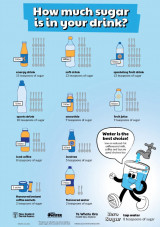
Credits: Healthify editorial team. Healthify is brought to you by Health Navigator Charitable Trust.
Reviewed by: Lily Henderson, Registered Dietitian
Last reviewed:


